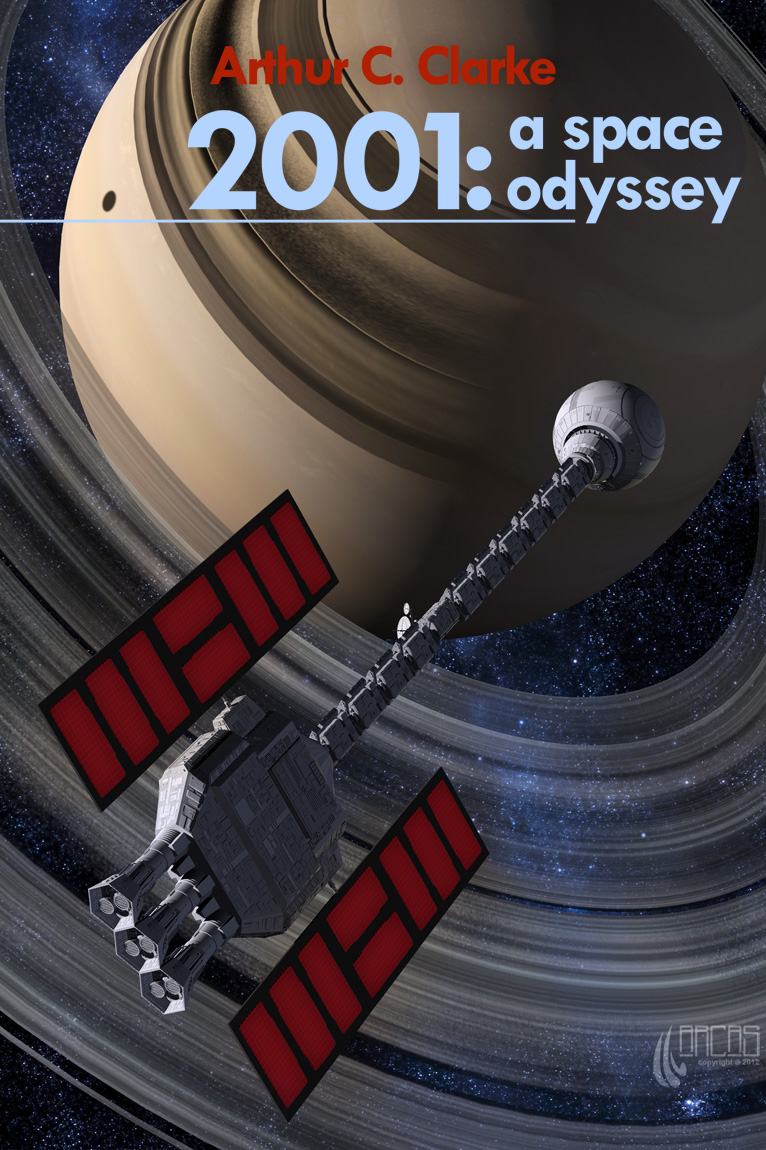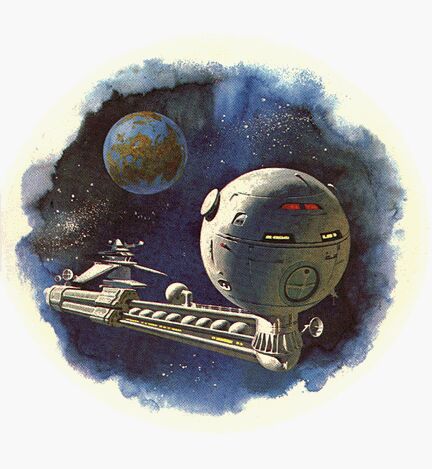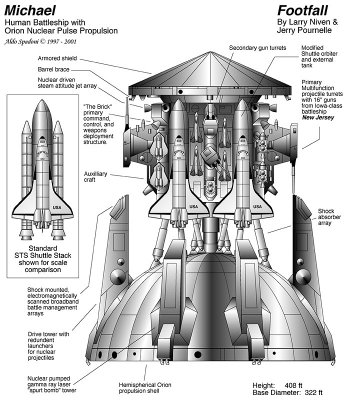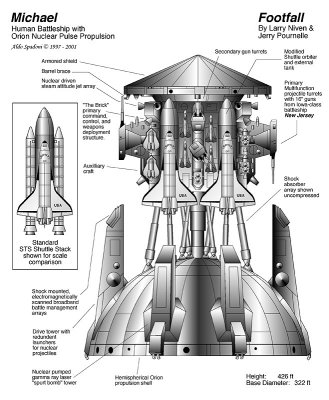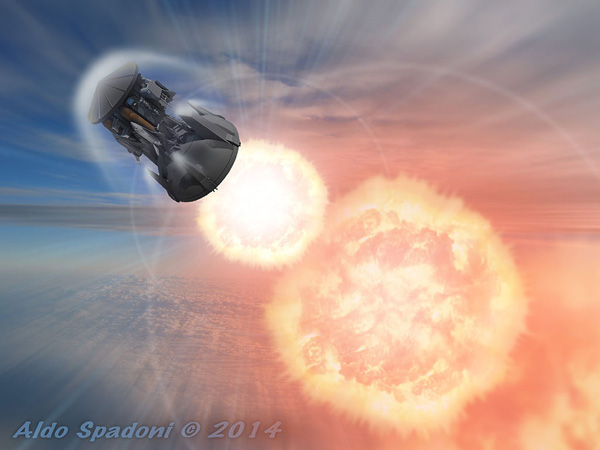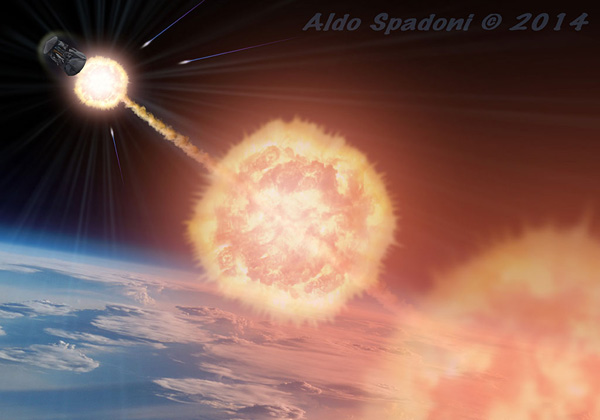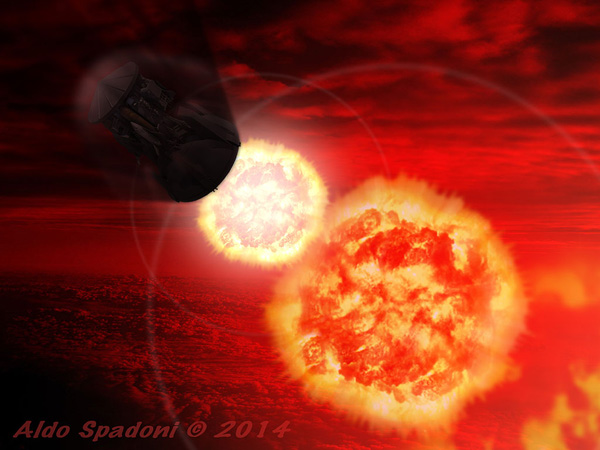Orion-powered Discovery from 2001
The final decision was made on the basis of aesthetics rather than technology; we wanted Discovery to look strange yet plausible, futuristic but not fantastic. Eventually we settled on the plasma drive, though I must confess that there was a little cheating. Any nuclear-powered vehicle must have large radiating surfaces to get rid of the excess heat generated by the reactors — but this would make Discovery look somewhat odd. Our audiences already had enough to puzzle about; we didn’t want them to spend half the picture wondering why spaceships should have wings. So the radiators came off.
There was also a digression — to the great alarm, as already mentioned, of the Art Department — into a totally different form of propulsion. During the late 1950’s, American scientists had been studying an extraordinary concept (“Project Orion”) which was theoretically capable of lifting payloads of thousands of tons directly into space at high efficiency. It is still the only known method of doing this, but for rather obvious reasons it has not made much progress.
Project Orion is a nuclear-pulse system — a kind of atomic analog of the wartime V-2 or buzz-bomb. Small (kiloton) fission bombs would be exploded, at the rate of one every few seconds, fairly close to a massive pusher plate which would absorb the impulse from the explosion; even in the vacuum of space, the debris from such a mini-bomb can produce quite a kick.
The plate would be attached to the spacecraft by a shock-absorbing system that would smooth out the pulses, so that the intrepid passengers would have a steady, one gravity ride — unless the engine started to knock.
Although Project Orion sounds slightly unbelievable, extensive theoretical studies, and some tests using conventional explosives, showed that it would certainly work — and it would be many times cheaper than any other method of space propulsion. It might even be cheaper, per passenger seat, than conventional air transport — if one was thinking in terms of million-ton vehicles. But the whole project was grounded by the Nuclear Test Ban Treaty, and in any case it will be quite a long time before NASA, or anybody else, is thinking on such a grandiose scale. Still, it is nice to know that the possibility exists, in case the need ever arises for a lunar equivalent of the Berlin Airlift...
When we started work on 2001, some of the Orion documents had just been declassified, and were passed on to us by scientists indignant about the demise of the project. It seemed an exciting idea to show a nuclear-pulse system in action, and a number of design studies were made of it; but after a week or so Stanley decided that putt-putting away from Earth at the rate of twenty atom bombs per minute was just a little too comic. Moreover — recalling the finale of Dr. Strangelove — it might seem to a good many people that he had started to live up to his own title and had really learned to Love the Bomb. So he dropped Orion, and the only trace of it that survives in both movie and novel is the name.
From Lost Worlds of 2001 by Sir Arthur C. Clarke (1972)
What if Stanley decided that the Orion Drive Discovery would fit in 2001?
It would not create many changes in the film.
I suspect that we would have a explanation of the drive during the interview with the Astronauts.
And Maybe see the Astronauts in their seats as the blasts take place.
And Hal explanation of the malfunction in the Communication Array would be that it was damaged during the last series of blasts.
The Big Question is what other Movies and Television Show would include Orion Drives in their Shows?
Any one have any ideas?
-
 Pre-production version of Discovery spacecraft for movie 2001 A Space Odyssey. The Orion propulsion system was later dropped. Click for larger image.
Pre-production version of Discovery spacecraft for movie 2001 A Space Odyssey. The Orion propulsion system was later dropped. Click for larger image.
The final decision was made on the basis of aesthetics rather than technology; we wanted Discovery to look strange yet plausible, futuristic but not fantastic. Eventually we settled on the plasma drive, though I must confess that there was a little cheating. Any nuclear-powered vehicle must have large radiating surfaces to get rid of the excess heat generated by the reactors — but this would make Discovery look somewhat odd. Our audiences already had enough to puzzle about; we didn’t want them to spend half the picture wondering why spaceships should have wings. So the radiators came off.
There was also a digression — to the great alarm, as already mentioned, of the Art Department — into a totally different form of propulsion. During the late 1950’s, American scientists had been studying an extraordinary concept (“Project Orion”) which was theoretically capable of lifting payloads of thousands of tons directly into space at high efficiency. It is still the only known method of doing this, but for rather obvious reasons it has not made much progress.
Project Orion is a nuclear-pulse system — a kind of atomic analog of the wartime V-2 or buzz-bomb. Small (kiloton) fission bombs would be exploded, at the rate of one every few seconds, fairly close to a massive pusher plate which would absorb the impulse from the explosion; even in the vacuum of space, the debris from such a mini-bomb can produce quite a kick.
The plate would be attached to the spacecraft by a shock-absorbing system that would smooth out the pulses, so that the intrepid passengers would have a steady, one gravity ride — unless the engine started to knock.
Although Project Orion sounds slightly unbelievable, extensive theoretical studies, and some tests using conventional explosives, showed that it would certainly work — and it would be many times cheaper than any other method of space propulsion. It might even be cheaper, per passenger seat, than conventional air transport — if one was thinking in terms of million-ton vehicles. But the whole project was grounded by the Nuclear Test Ban Treaty, and in any case it will be quite a long time before NASA, or anybody else, is thinking on such a grandiose scale. Still, it is nice to know that the possibility exists, in case the need ever arises for a lunar equivalent of the Berlin Airlift...
When we started work on 2001, some of the Orion documents had just been declassified, and were passed on to us by scientists indignant about the demise of the project. It seemed an exciting idea to show a nuclear-pulse system in action, and a number of design studies were made of it; but after a week or so Stanley decided that putt-putting away from Earth at the rate of twenty atom bombs per minute was just a little too comic. Moreover — recalling the finale of Dr. Strangelove — it might seem to a good many people that he had started to live up to his own title and had really learned to Love the Bomb. So he dropped Orion, and the only trace of it that survives in both movie and novel is the name.
From Lost Worlds of 2001 by Sir Arthur C. Clarke (1972)
What if Stanley decided that the Orion Drive Discovery would fit in 2001?
It would not create many changes in the film.
I suspect that we would have a explanation of the drive during the interview with the Astronauts.
And Maybe see the Astronauts in their seats as the blasts take place.
And Hal explanation of the malfunction in the Communication Array would be that it was damaged during the last series of blasts.
The Big Question is what other Movies and Television Show would include Orion Drives in their Shows?
Any one have any ideas?
